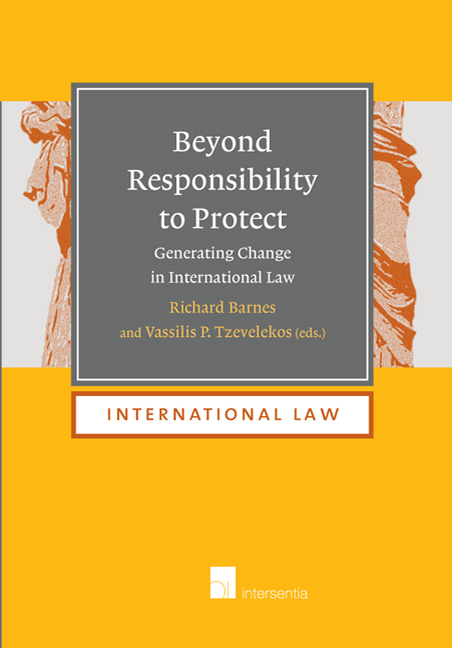Book contents
- Frontmatter
- Dedication
- Foreword
- Acknowledgements
- Contents
- Table of Cases
- List of Authors
- Introduction
- Part I The Moral Underpinnings and Political Ends of R2p
- Part II International Institutions And Their Role In R2p
- PART III De Facto Regimes and Non-State Actors Within a State And as a State
- Part IV R2p and Due Dilligence Regarding the Conduct of Corporations
- Part V The Interaction Between R2p And Humanitarian Law Obligations To Protect Civilian Populations
- The Responsibility to Protect Doctrine, and the Duty of the International Community to Reinforce International Humanitarian Law and its Protective Value for Civilian Populations
- The Responsibility to Protect in Armed Conflict: A Step Forward for the Protection of Civilians?
- Commentary: On the Intersection of the Responsibility to Protect, the Protection of Civilians and International Humanitarian Law in Contemporary Armed Conflicts
- PART VI R2p and International Criminal Law Beyond the Four R2p Crimes
- Part VII R2p and its Possible Impact on the Law of International Responsibility
- Part VIII Concluding Observations
- Index
The Responsibility to Protect Doctrine, and the Duty of the International Community to Reinforce International Humanitarian Law and its Protective Value for Civilian Populations
from Part V - The Interaction Between R2p And Humanitarian Law Obligations To Protect Civilian Populations
Published online by Cambridge University Press: 19 September 2018
- Frontmatter
- Dedication
- Foreword
- Acknowledgements
- Contents
- Table of Cases
- List of Authors
- Introduction
- Part I The Moral Underpinnings and Political Ends of R2p
- Part II International Institutions And Their Role In R2p
- PART III De Facto Regimes and Non-State Actors Within a State And as a State
- Part IV R2p and Due Dilligence Regarding the Conduct of Corporations
- Part V The Interaction Between R2p And Humanitarian Law Obligations To Protect Civilian Populations
- The Responsibility to Protect Doctrine, and the Duty of the International Community to Reinforce International Humanitarian Law and its Protective Value for Civilian Populations
- The Responsibility to Protect in Armed Conflict: A Step Forward for the Protection of Civilians?
- Commentary: On the Intersection of the Responsibility to Protect, the Protection of Civilians and International Humanitarian Law in Contemporary Armed Conflicts
- PART VI R2p and International Criminal Law Beyond the Four R2p Crimes
- Part VII R2p and its Possible Impact on the Law of International Responsibility
- Part VIII Concluding Observations
- Index
Summary
INTRODUCTION: INTERNATIONAL HUMANITARIAN LAW AND R2P AS NECESSARY ALLIES
The responsibility to protect doctrine (R2P) was once described by Michael Ignatieff, one of its architects, as follows: ‘A tyrant who butchers his people forfeits his right to rule, or suspends his right to rule. If he won't protect his people then someone else should’. In an open letter where he was arguing in favour of a military option to address the situation in Libya in 2011, former Australian foreign minister Gareth Evans, stated that ‘state sovereignty is not A licence to kill. No state can abdicate the responsibility to protect its people from crimes against humanity, let alone justify perpetrating such crimes’. More recently, Russian Foreign Minister Sergey Lavrov evoked R2P language, as a justification for the military intervention in Crimea, stating that ‘we are talking here about protection of our citizens and compatriots, about protection of the most fundamental of the human rights’.
When invoked to support a military intervention in a third state, regardless of what the underlying intention is, it is apparent that R2P challenges the current international legal order, at least in its traditional form. Indeed, the legal order set forth in the Peace of Westphalia in the seventeenth century rests on three main pillars: the state as the (main) subject of law, state sovereignty, and reciprocity. State sovereignty is currently enshrined in the first paragraph of Article 2 of the United Nations Charter; its corollary principle of non-intervention in states’ domestic affairs is also enshrined in the same Article, under paragraph. In the traditional dynamics of the international legal order, a conditional relationship between the two concepts was established: sovereignty can only be enjoyed by a state if it respects every other state's sovereignty.
Many aspects of public international law and international relations pose challenges to state sovereignty. When peoples assert their right to selfdetermination, or when heads of states are held personally accountable for violations of the law and customs of war, the sovereignty of the state in question is somehow compromised. That being said, R2P, with its new approach to intervention on human protection grounds, changes the fundamentals of the rapport between sovereignty and non-intervention.
- Type
- Chapter
- Information
- Beyond Responsibility to ProtectGenerating Change in International Law, pp. 251 - 268Publisher: IntersentiaPrint publication year: 2016



